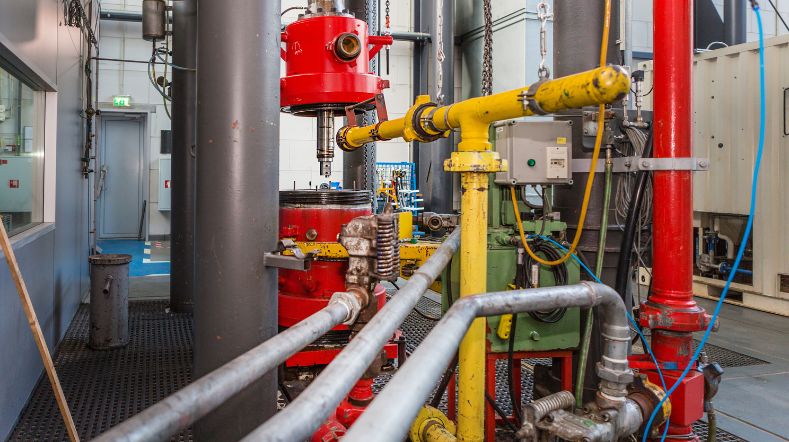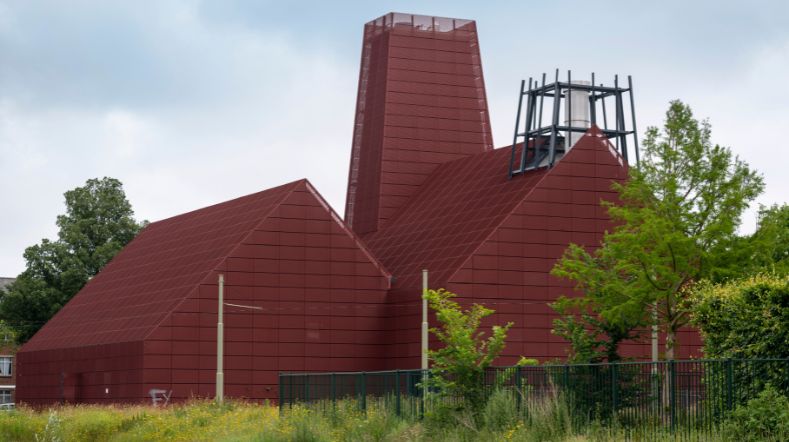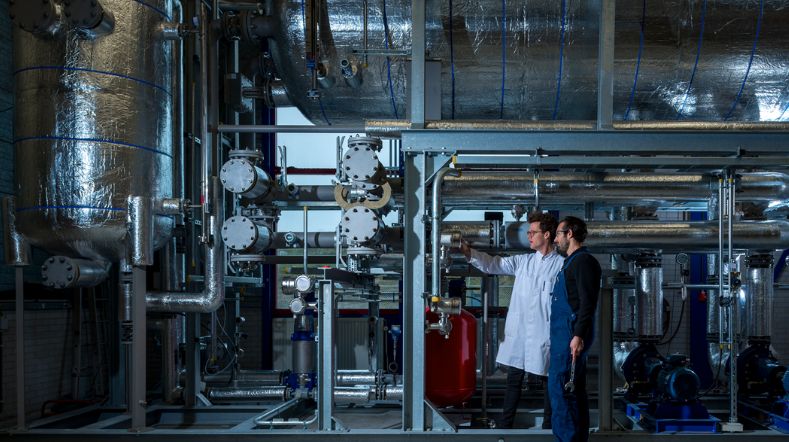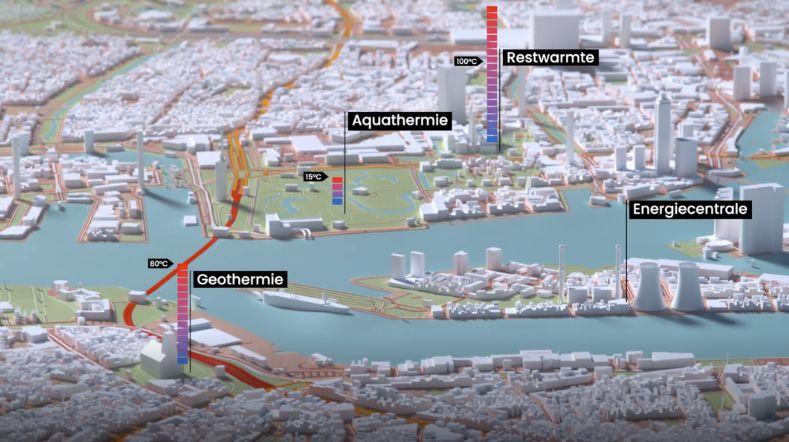Limited growth in geothermal energy production in 2023 but a record number of drilling operations
Geothermal energy is important for the sustainability of existing heating networks or as a heat source for new heating networks. The Dutch government has an ambition that 15 petajoules (PJ) of geothermal energy is produced in the Netherlands by 2030. The geothermal sector aims for 40 to 50 PJ that year. An analysis by TNO of recent production data shows that the growth in geothermal energy production in 2023 is minimal.
6 key points report geothermal energy in the Netherlands
This research with geothermal production figures and a production forecast is part of TNO’s annual report for the Ministry of Climate and Green Growth. In the annual report 'Natural resources and Geothermal Energy in the Netherlands' TNO analyzes the progress regarding geothermal drilling, permits, and production of geothermal energy extracted at depths ranging from 500 to 4000 meters.
The key findings are:
- In 2023, 6.88 PJ of geothermal energy was produced, an increase of only 1% compared to 2022.
- The development of geothermal energy in the built environment significantly lags behind that in greenhouse horticulture. This is likely due to the greater complexity of heat delivery and is expected to continue in the short term.
- In the short term, high investment costs and consequently a relatively high project risk appear to be delaying factors in the growth of geothermal energy production in the Netherlands.
- In the long term, further exploration of the subsurface in data-poor areas is necessary to continue the growth of geothermal energy production.
- In 2023, 13 geothermal wells were drilled, a record number. The newly realised geothermal installations will only start contributing to heat production in the coming years.
- It is expected that the government’s ambition of 15 PJ by 2030 can be achieved.
Record number of drilling operations
In 2023, 13 geothermal wells were drilled, a record number. Of these, one was an exploratory well under the SCAN programme. The remaining 12 wells resulted in six new geothermal installations. These installations did not contribute to heat production in 2023 but will become operational in the coming years.
Above-ground heat demand
As of 1 January 2024, there were 119 active geothermal licenses and five license applications. The (applications for) geothermal licenses have a heat demand from either greenhouse horticulture or the built environment, which is almost equally divided.
However, most start-up and follow-up licenses with an operational geothermal installation have a heat demand from greenhouse horticulture. The development of geothermal energy to provide heat for the built environment is significantly lagging. To date, only two start-up licenses and one follow-up license have been granted for this purpose.
Stagnation in geothermal energy production growth
In 2023, twenty operational geothermal installations collectively produced 6.88 PJ of geothermal energy. This is only 0.08 PJ (1%) more than the production in 2022. A preliminary estimate of production in 2024 suggests an expected production of 7 PJ, which is 0.12 PJ (2%) more than the production in 2023. If this indeed turns out to be the final result for 2024, the growth in geothermal energy production over the past two years is limited.
Future geothermal energy production forecasts
To assess the various ambitions for 2030, TNO has developed five production forecasts. The forecasts range from merely optimising existing installations to significant growth in geothermal energy, where almost all granted geothermal permits lead to realised projects by 2030:
- Only optimisation of existing installations;
- Only the six new geothermal installations becoming operational;
- Limited growth in geothermal energy production: two new installations per year;
- Significant growth in geothermal energy production: realisation of all approved SDE++ projects (The Stimulation of Sustainable Energy Production and Climate Transition provides subsidies to companies and non-profit organisations that generate large-scale renewable energy or reduce CO2 emissions);
- Significant growth in geothermal energy production: realisation of projects in almost all granted geothermal licenses.
In two of these forecasts, the government’s ambition is met, with geothermal energy production of 19.82 PJ and 34.52 PJ compared to the ambition of 15 PJ. The sector’s ambition is not met in any of the forecasts.
| Number of operational geothermal installations | Heat production (PJ) in 2030 | |
|---|---|---|
| Government ambition | 75 | 15 |
| Sector ambition | 175 | (40 to) 50 |
| No acceleration, only optimisation (0.08 PJ/year) | 20 | 7,44 |
| No acceleration, only the 6 new installations | 26 | 9,78 |
| Limited growth (0.9 PJ/year) | 34 | 13,38 |
| Significant growth with realisation of SDE++ projects | 53 | 19,82 |
| Significant growth with realisation of most projects | 103 | 34,52 |
Bottlenecks to growth
In the short and long term, several bottlenecks hinder the growth of geothermal energy in the Netherlands and make the aformentioned forecasts uncertain:
- In the short term, the relatively high project risk combined with high installation costs from own capital is a bottleneck for the realisation of geothermal installations. However, the costs per installed capacity are relatively favourable compared to other sustainable heat sources. Heat delivery is delayed by an increase of the duration between the drilling phase and the production phase.
- The complexity of geothermal heat delivery, particularly to the built environment, is a significant short-term bottleneck that prevents strong growth in geothermal energy production. Due to varying heat demand between seasons and the many individual connections, geothermal heat delivery is more complicated than in greenhouse horticulture.
- In the long term, the geothermal sector needs to invest in exploring the subsurface in areas with little to no data. This is important to gain more certainty about the economic viability of geothermal energy in those areas. Drilling an exploration well is a costly investment and is currently unattractive for many companies.
Ambition can be achieved
The Dutch government’s ambition to have production of 15 PJ of geothermal energy by 2030 can probably be achieved. However, it is important that several projects (at least an average of three) are realized each year to achieve this. The number of new installations per year is difficult to estimate due to the aforementioned bottlenecks. Additionally, a longer period between drilling and the actual production could further delay heat delivery. It is expected that most of the growth in the coming years will be in the greenhouse horticulture.
Want to know more?
Read more about TNO's analysis of the effectiveness of geothermal heat production and the five production projections of expected future geothermal heat production in the Netherlands in the report 'Geothermal Heat in the Netherlands.'
Get inspired
TNO–SodM–NIOZ: ‘Methane emissions in the North Sea often linked to shallow natural gas’


Heat


Geothermal energy: sustainable heat from the subsurface


Smarter storage: how TNO optimises thermal energy storage


Heat system integration: aligning all the pieces


